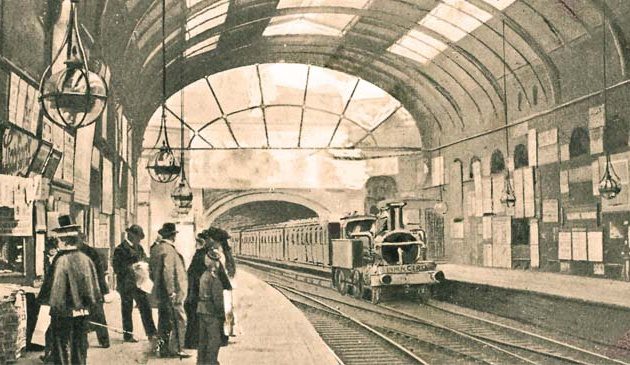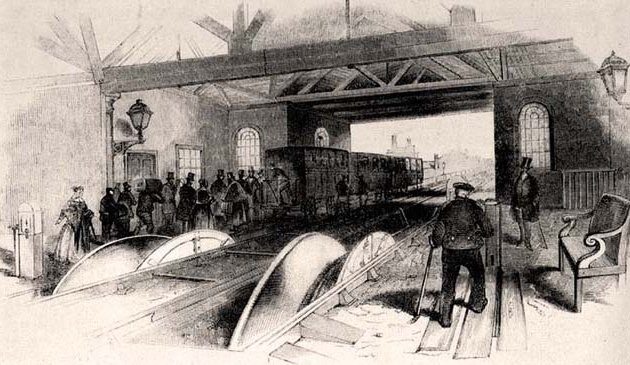London’s first underground railway

The image shows VIPs on a demonstration run on the Metropolitan Railway, perhaps prior to its opening. The carriages behind the locomotive are first-class while those at the back, in the foreground, are probably third-class. The train is running on the broad-gauge rails of the Great Western Railway. An inner rail can be seen, allowing standard gauge trains of the Great Northern and other companies to use the line.
The idea of creating a railway under London was revolutionary, risky, and expensive. To operate under a city on the scale of London’s first underground railway had never been considered anywhere in the world. Even after its evident success it took a long time for any other city to attempt it: the Paris Metro was created after a further forty years and New York’s subway even later.
The population of London greatly increased during the 19th century and likewise the traffic on the capital’s streets. The City and Westminster in particular were clogged with horse-drawn vehicles of many sorts. Railways carried people into and out of London to other parts of the country via termini and it was in the interest of the railway companies to bring their lines into the centre of town. Yet the Royal Commission on Metropolis Railway Termini of 1846 decided on a circular boundary within which railways were not permitted to enter, so each new railway line that connected to the rest of the country ended on the edges of Central London. Anyone arriving from those termini had to use omnibuses, hansom cabs, or carriages, to complete their journey, adding to the slow-moving traffic.
A solution would be an underground railway that took passengers off the roads. An important figure in that respect was Charles Pearson, the solicitor of the City of London Corporation from 1839. He was a great campaigner on social and railway issues over many years and proposed an underground railway from King’s Cross to Farringdon. The City Terminus Company was created in 1852 for that purpose.
In the same year another group created the Bayswater, Paddington & Holborn Bridge Railway Company with a plan to construct an underground line from Paddington to meet the City Terminus Company line at King’s Cross. The company’s chairman, William Mallins, fully understood that London was so congested that it was becoming difficult for traffic to move around. That scheme received Parliamentary approval in 1853. In the meantime, the City Terminus scheme was rejected by Parliament but then merged with the Paddington to King’s Cross plan. A new Parliamentary Bill was submitted, with the route extended from Paddington to the General Post Office at St. Paul’s via Farringdon. The company name then changed to the Metropolitan Railway.
This new Act was passed in August 1854. It then took a further four years to raise the necessary capital, which was not easy during the Crimean War for an unproven concept. When they were on the point of giving up, the Corporation of the City of London provided £200,000 at Pearson’s insistence because, as he had long expounded, it would relieve traffic on their congested streets and allow workers to commute to and from their place of work. The Great Western Railway also made an investment so the line could bring people to and from its terminus at Paddington.
The City was London’s primary district for employment and to where people needed to commute. Before work commenced the route was shortened to Farringdon to save costs and reduce opposition, never reaching the General Post Office. After King’s Cross, the line followed Farringdon Road to Farringdon Street, close to the City at Smithfield, taking almost the same route as the first omnibuses three decades earlier. Although the eastern terminus would then be just to the north, the City was still easily accessible on foot or by omnibus. The Metropolitan would connect the railway termini at Paddington, Euston, and King’s Cross, and with intermediate stations at Edgware Road, Baker Street, Portland Road (Great Portland Street), and Gower Street (Euston Road).
The chief engineer for the work was John Fowler, who had previously created railways in Yorkshire and Lincolnshire. Work commenced in the spring of 1860. It was built using the ‘cut and cover’ method whereby a channel was dug, the railway laid, and then covered over. The line passed just below the level of buildings and streets. The section eastwards from Bishop’s Road was dug under the New Road, today’s Marylebone and Euston Roads. The 700-yard eastern section, which passed along the Fleet Valley between King’s Cross and Farringdon, however, involved the demolition of perhaps 1,000 houses, displacing 12,000 people. Spoil from the tunnelling was taken to Stamford Bridge, the future site of the Chelsea Football Club stadium.
Inevitably there were issues caused by creating a tunnel through a built-up area and only just below the surface. The submerged River Fleet crossed the route three times through sewers. On one occasion in June 1862 it burst out due to heavy rain, causing flooding that created a delay of a few months and increased costs.
While construction was still in progress trial runs took place. It was important to allay fears amongst the public of travelling underground. In May 1862 it became possible to pass along the entire route with a train of distinguished guests including Chancellor of the Exchequer, William Gladstone.


